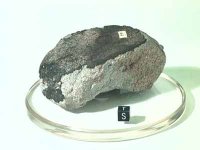Al D
Bronze Member
Hilariously funny, 


Hilariously funny,
Can you answer how the lunar feldspar differs from the earth? (Anorthositis from our planet)
I personally have not seen a fall. I have a witness of the fall of a meteor, who even heard the "sound of the fall." And my first “slag” was inside the “volcanic breccia,” which I cleaned with a hammer.
The last stone does not apply to the samples shown above. This was discovered by chance when searching with a metal detector near a meteorite fall in 1787.
